You are using an out of date browser. It may not display this or other websites correctly.
You should upgrade or use an alternative browser.
You should upgrade or use an alternative browser.
Soranik MEMS-3
- Added by grumpy213
- Create date
-
- Tags
- ear speaker iem soranik xmems
o0genesis0o
Headphoneus Supremus
Pros: + Outstanding resolution, details, and imaging precision
+ Great dynamic (with the right track)
+ Great subbass rumble and texture
+ Great dynamic (with the right track)
+ Great subbass rumble and texture
Cons: - Tonality needs further refinement
- The need for a separate energizer unit
- The need for a separate energizer unit
Today, we look at one of the first IEMs with full-ranged xMEMS driver on the market, the Soranik MEMS-3
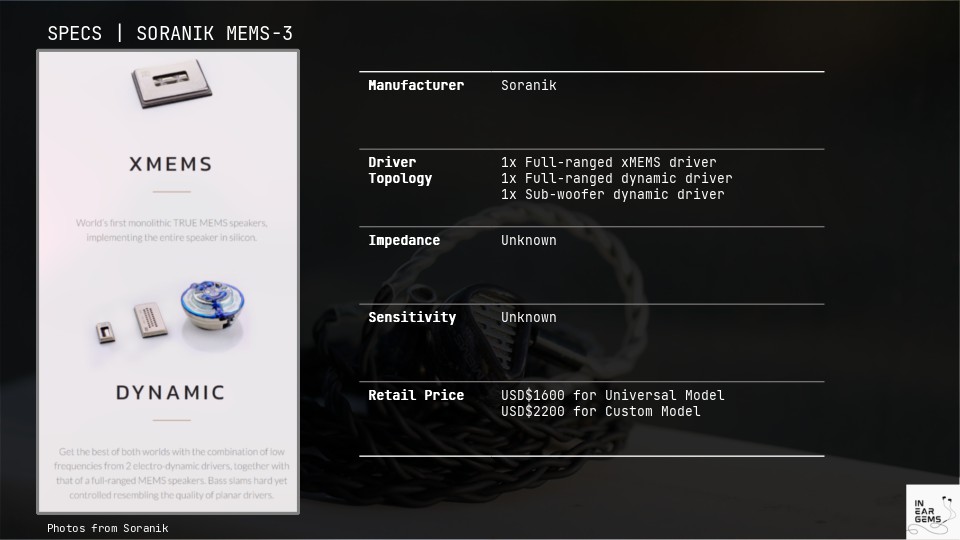
MEMS-3 is the second IEMs equipped with MEMS drivers from the Vietnamese boutique Soranik. It is available in both universal and custom moulded form factor (CIEM). Each side of this IEM contains one full-ranged xMEMS driver, one full-ranged dynamic driver, and one sub-woofer dynamic driver, all of which are housed within a 3D printed shell with open-back design. The star of the show is, of course, the full-ranged MEMS driver from the manufacturer xMEMS, which promises a significant leap in resolution and details due to the lightning-fast response of this new driver type. If you are curious about MEMS drivers in general, please have a look at my previous review article of HiBy Xeno where I went into more details and provided some references to follow up.
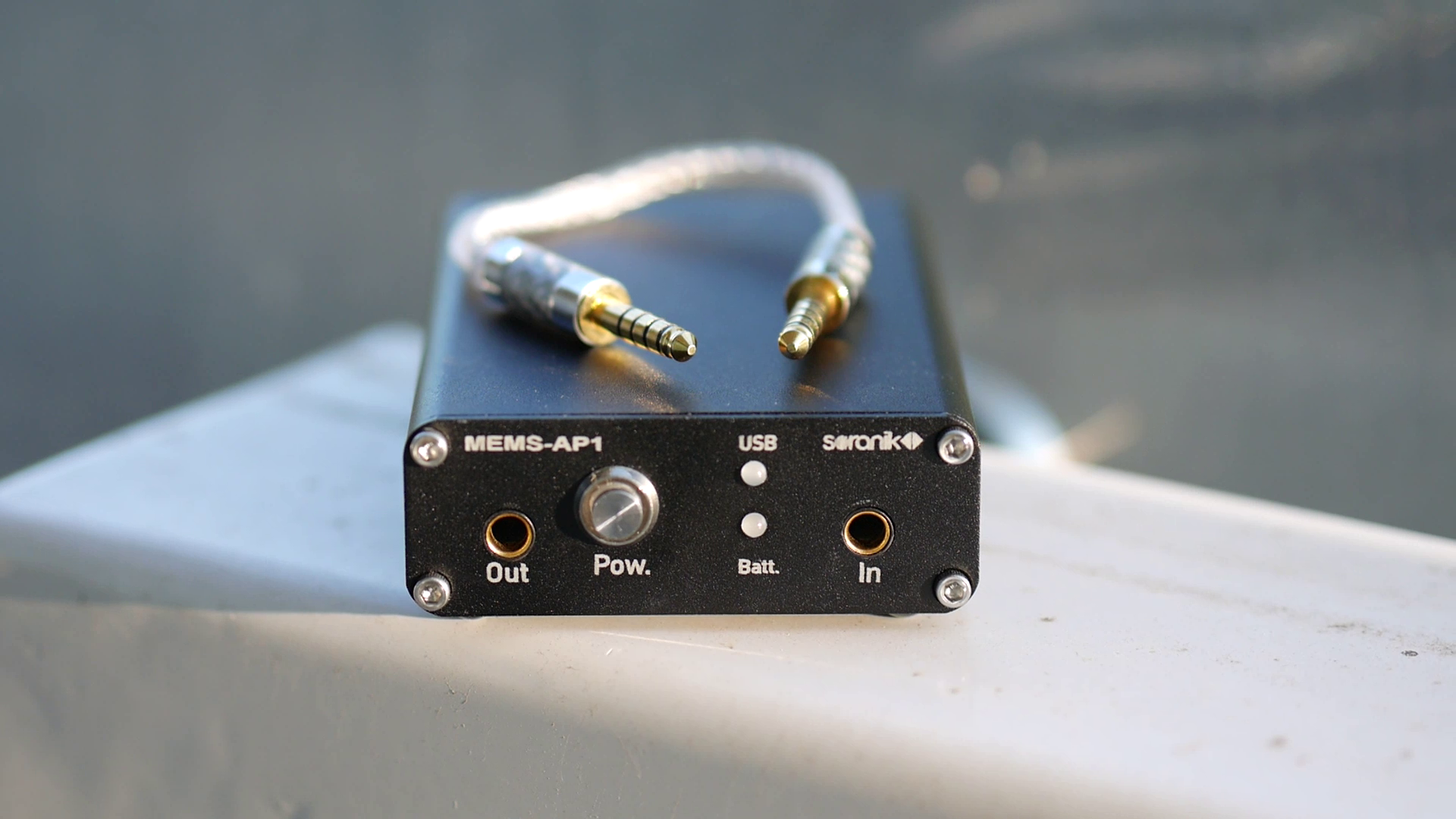
One critical point to notice is that MEMS-3 must be connected to an (included in the box) energizer unit boost the voltage of the signal enough for MEMS drivers to work. The energizer accepts an input analog signal via a 4.4mm jack, and output the amplified signal via another 4.4mm to the earpieces. You can use amplified signal from your dongle DAC or DAP as input to the energizer unit if you don’t have access to a 4.4mm lineout. In my tests, I found that MEMS-3 sounds better from the phone out than line out of my DAP.
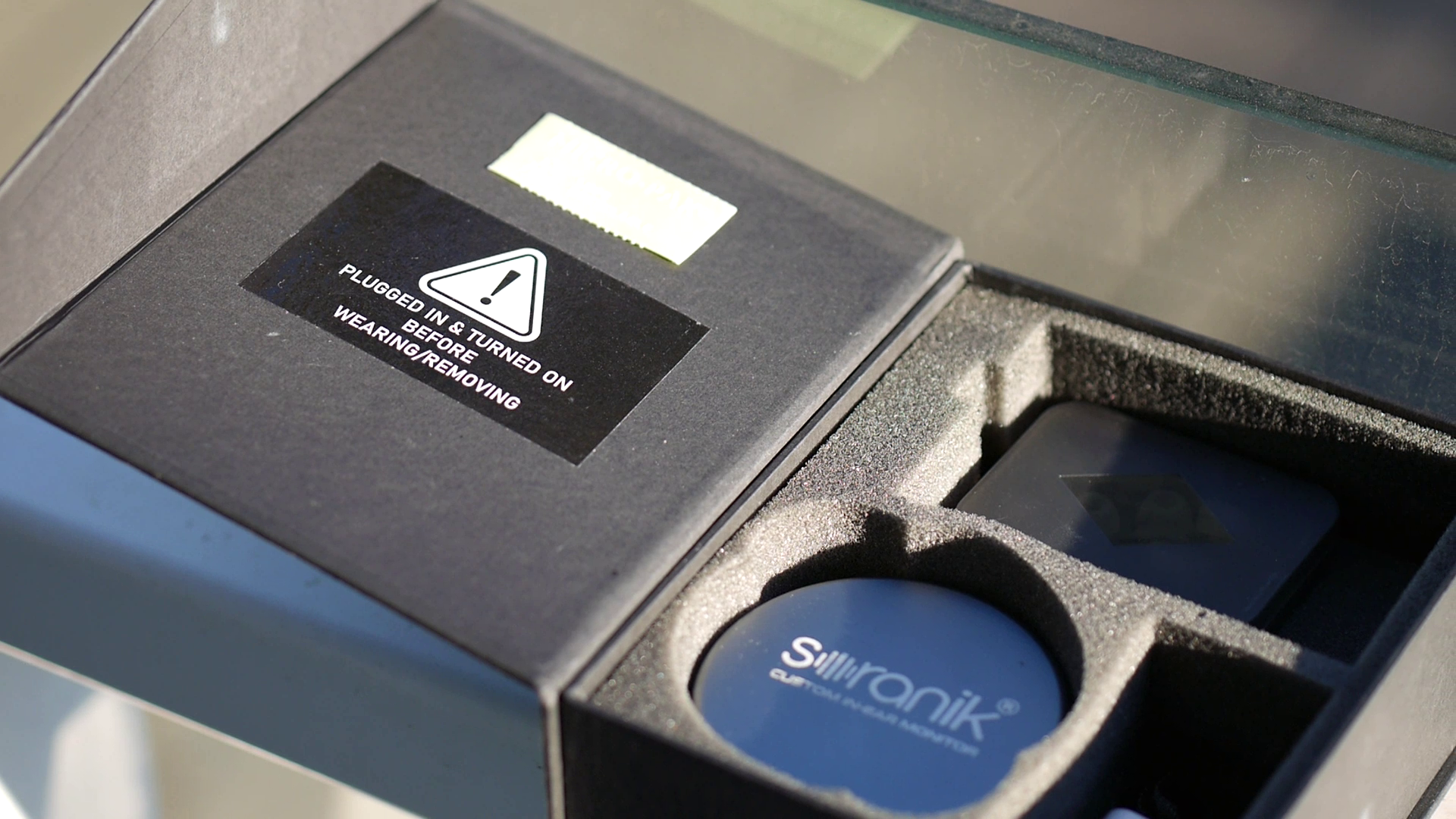
Due to the high voltage involved in operating MEMS-3, you need to follow the safety procedure outlined by Soranik. In particular, you need to ensure that everything is properly powered on and plugged in and turn the volume to a low level before wearing the IEMs. Personally, I also ensure that the audio content starts properly before putting the IEMs near my ears to avoid any software mishaps. That said, there is still somewhat unease feeling when using MEMS-3, which I expect would pass with prolonged exposure.
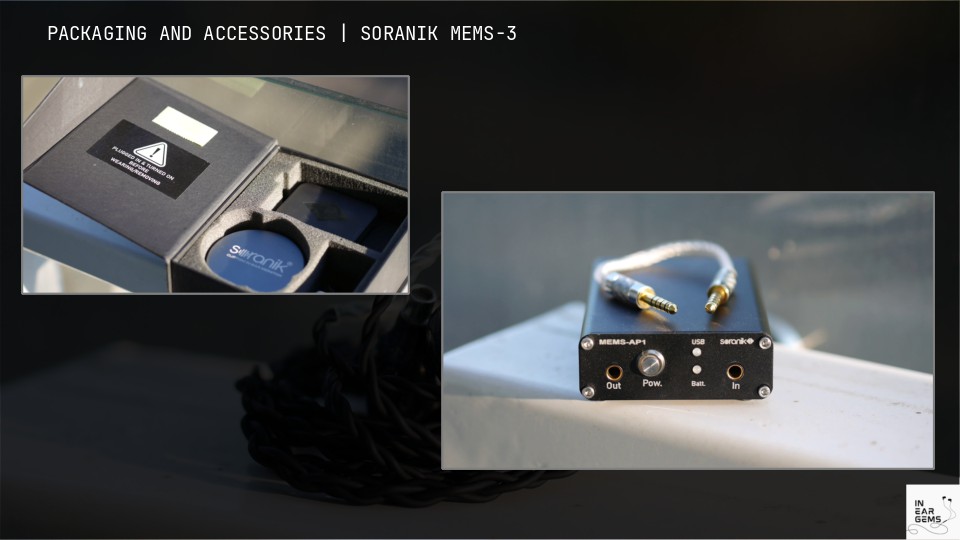
Soranik was not very fancy with the packaging. However, they supply MEMS-3 with a generous accessory pack, including a metal puck case that actually fit the IEM and cable. The included cable has a rubbery coating that feels somewhat annoying at first, but I quickly grew to like the cable due to how soft and easy to handle it is.
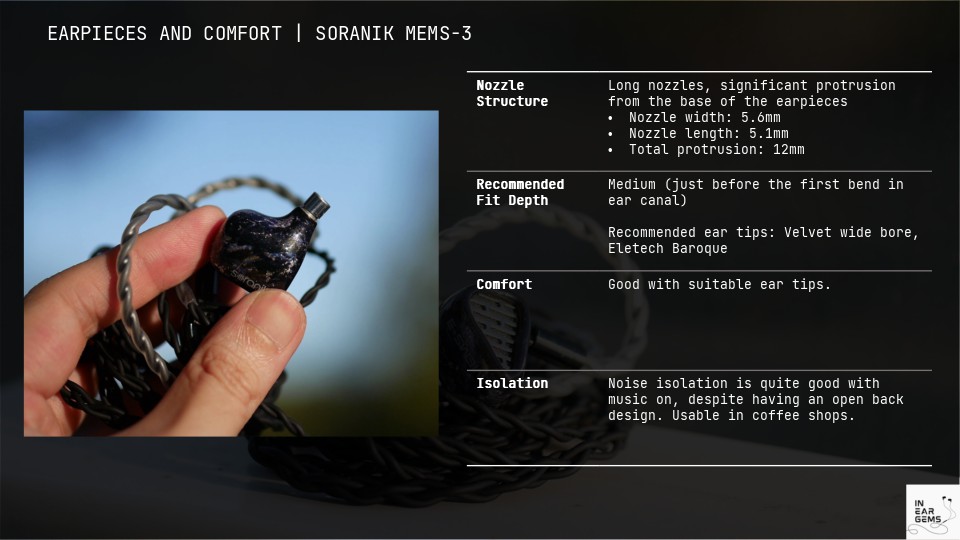
MEMS-3 earpieces are very well built. I have never seen the pattern of the resin in any other IEMs, and the finishing of the earpieces is flawless. The only problem here is the length of the nozzle, which makes a deep and stable fit impossible. The best I can do is to use shorter ear tips like Eletech Baroque to reach a medium fit, and let the rest of the earpieces sitting away from the concha. This fit reminds me of some of older Jerry Harvey IEMs, and that’s not a good memory. That said, with Baroque tips, I can listen to this IEMs for hours without getting ear fatigue.
Timbre and tonality:
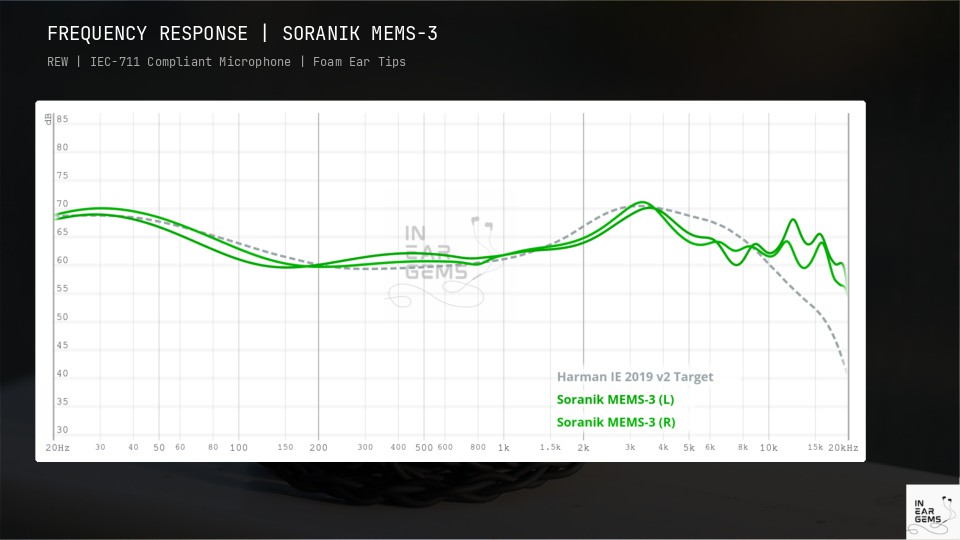
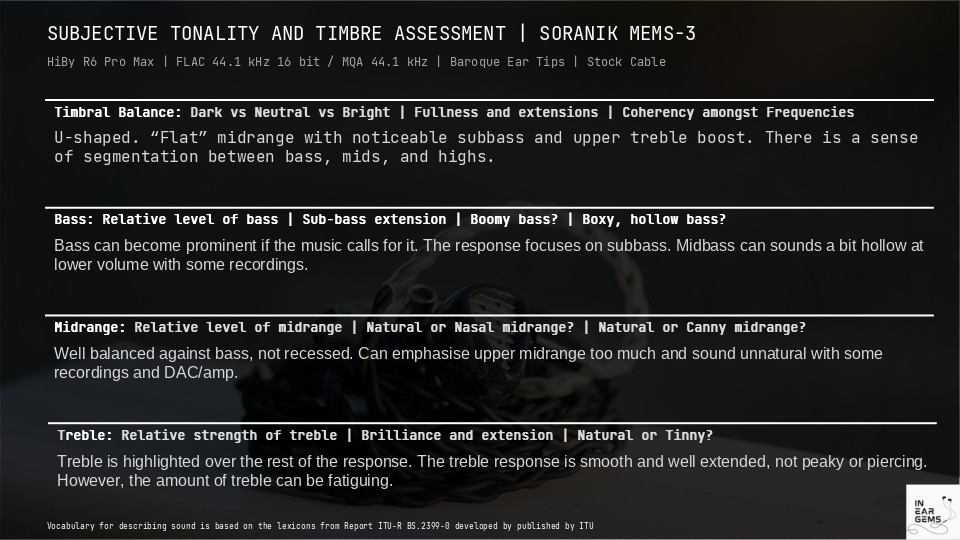
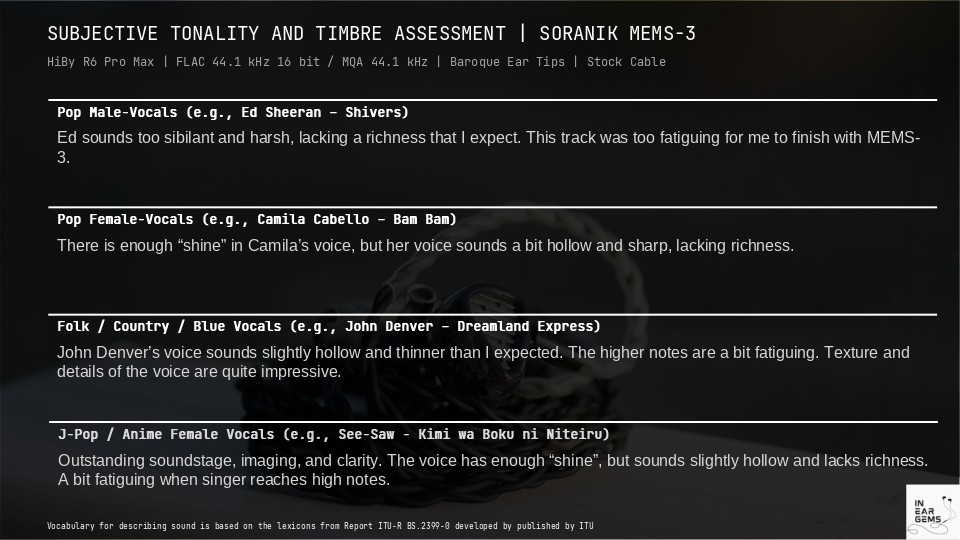
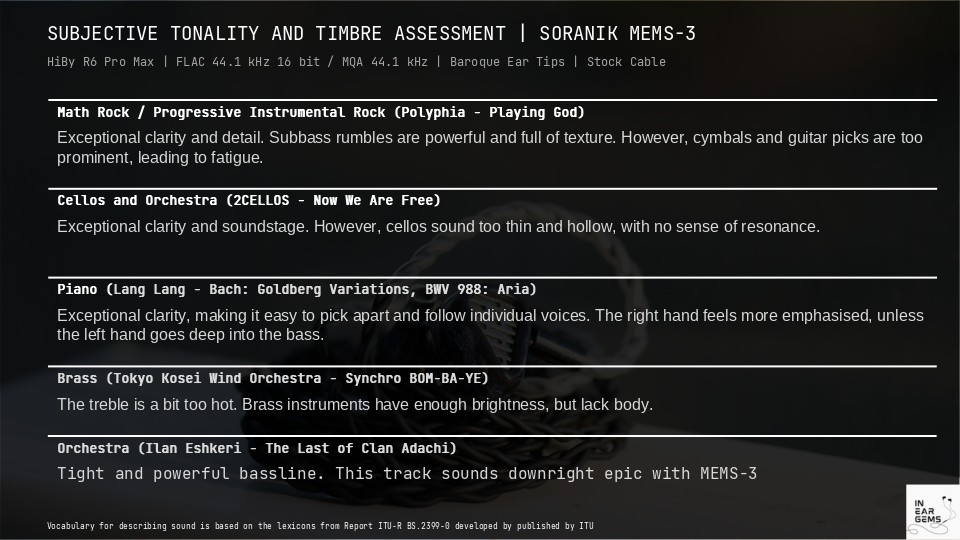
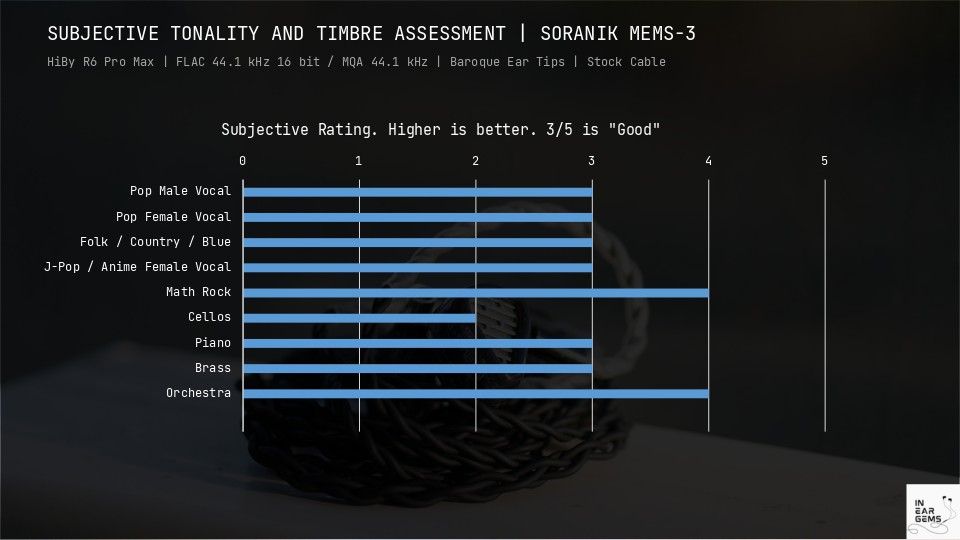
MEMS-3 has a U-shaped sound signature that looks really nice on the graph, with tightly tucked bass shelf, flat by-the-book midrange, and well extended yet smooth treble. Yet, the actual listening experience where these parts fit together was less than ideal, at least with some parts of my library.
MEMS-3 does a great job with more energetic, “epic” orchestral recordings such as from video game soundtracks. Where it really struggles (or at least were I really struggle with this IEM) is vocal music and acoustic recordings. I found that these problems boil down to three issues:
“You talk a lot, show me what you got!” you might say. I have created a PEQ to address these short-comings and I found MEMS-3 becomes much more enjoyable with this profile. Interestingly, the response after EQ seems to align, in principles, with the response of Soranik flagship model MEMS-3S.
(I will update this article with the PEQ profile after extracting it from my DAP)
Percussion, Bass, and perceived dynamic:
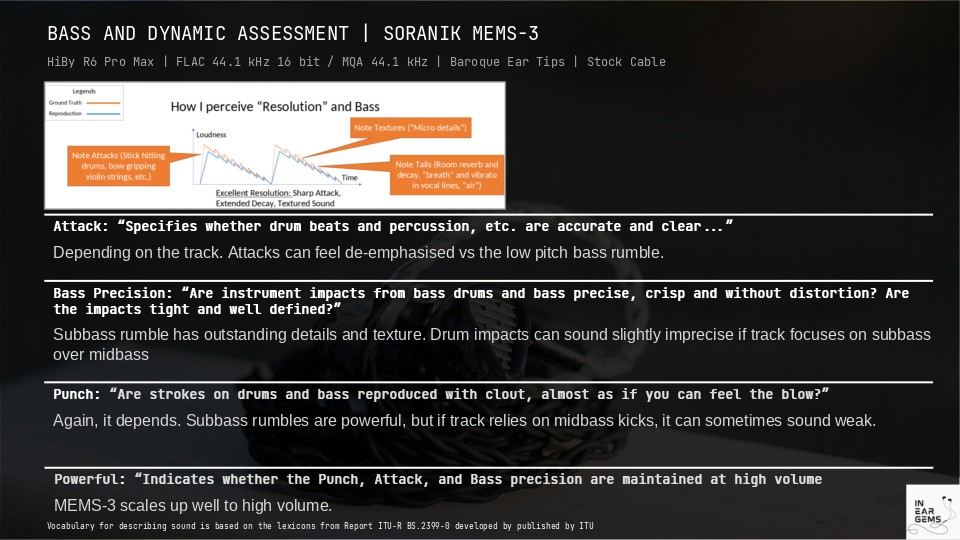
MEMS-3 has a sub-bass focus response with all the pros and cons of this bass tuning. When you listen to sub-bass content, you will be impressed by the power and control of the sub-woofer. And then you will find some tracks unusually hollow if they rely on mid-bass kicks instead of sub-bass rumbles. That said, the sub-woofer is highly capable and responds to EQ well. If you boost the mid-bass by a few dB, you can have the best of both worlds.
Resolution:
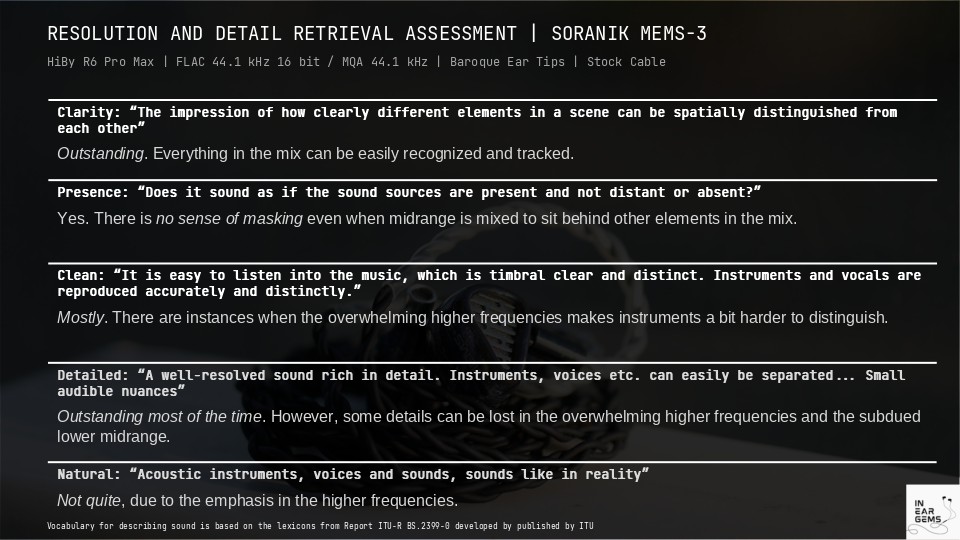
In one word: outstanding. Everything has a precise place on the soundstage, and nothing masks anything else. You can listen down to the most minute details that your DAC can pulls out. This characteristic also makes MEMS-3 an interesting IEM to test and compare different DAC and amplifiers.
Stereo imaging and soundstage:
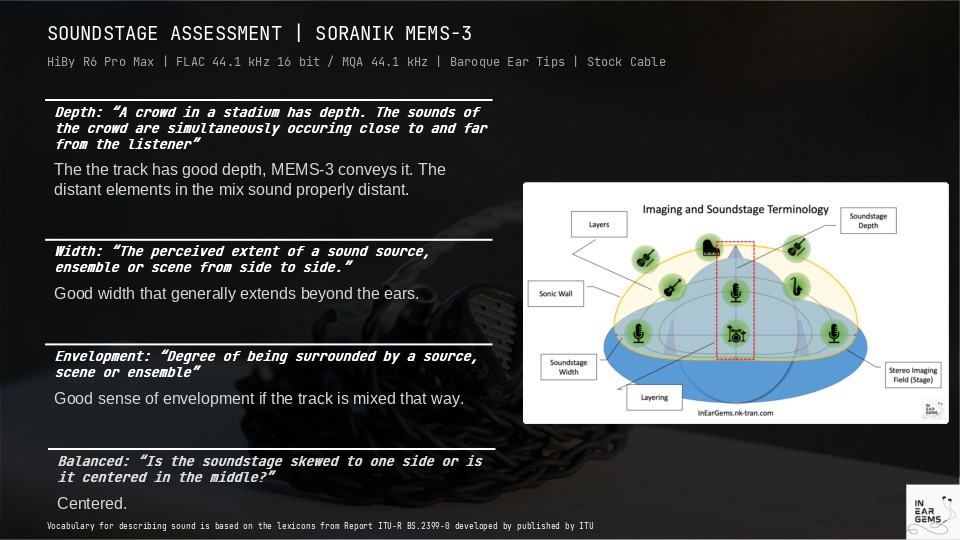
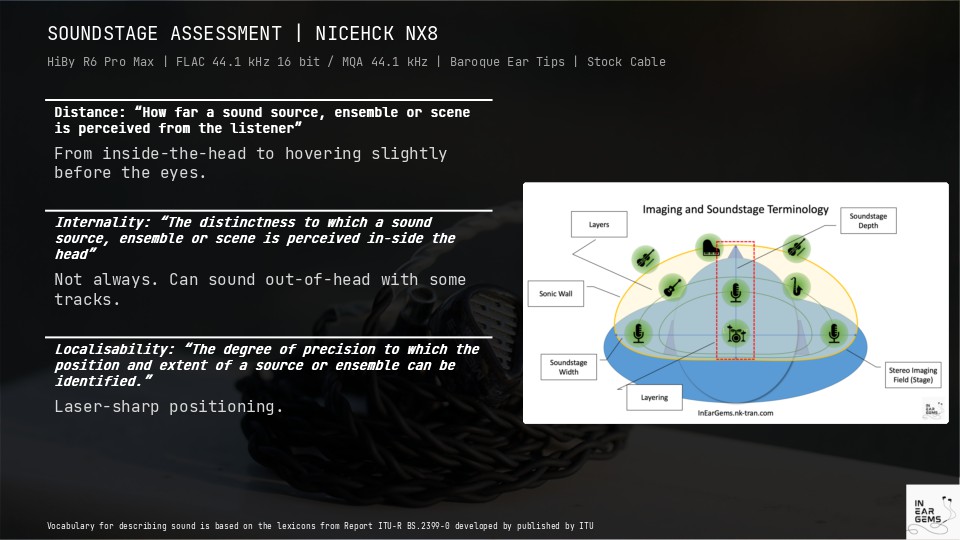
Imaging and staging are other areas where MEMS-3 impresses. Surprisingly, the open-back design does not sound that “open” to me. Despite this “limitation”, MEMS-3 still convey a great sense of space and capable of casting background, distant elements in the mix into the distant around me. Live recordings with real audiences are a treat with this IEM.
What I like about this IEM:
What could be improved:
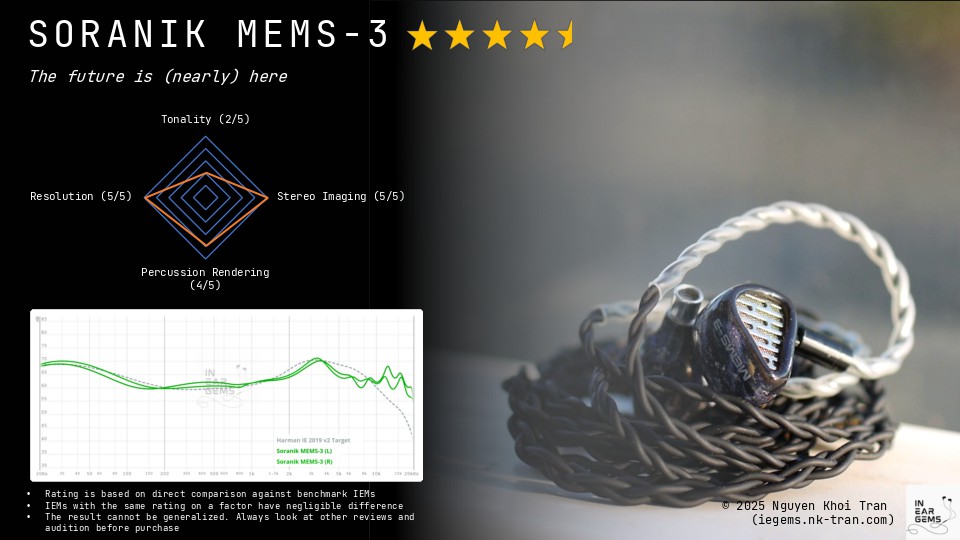
Updated: March 2, 2025
Forewords
- What I look for in an IEM is immersion. I want to feel the orchestra around my head, track individual instruments, and hear all of their textures and details. I’m not picky about tonality, as long as it does not make the orchestra, violin, cellos, and pianos sound wrong.
- I rate IEMs within with a consistent scale from 1 (Poor) to 3 (Good) to 5 (Outstanding). An overall ranking of 3/5 or above is considered positive.
- Ranking list and measurement database are on my IEM review blog.
- The terminology for subjective impressions in this review is based on the Audio Wheel for reproduced sound defined in the technical report ITU-R BS.2399-0
- This review is based on the Australian Head-Fi tour arranged by Soranik and @Damz87 (Thank you!). I have no affiliation with or financial interest in Soranik.
- The unit retails for US$1600 at the time this review was published. Unaffiliated link: Soranik Web Store
General Information

MEMS-3 is the second IEMs equipped with MEMS drivers from the Vietnamese boutique Soranik. It is available in both universal and custom moulded form factor (CIEM). Each side of this IEM contains one full-ranged xMEMS driver, one full-ranged dynamic driver, and one sub-woofer dynamic driver, all of which are housed within a 3D printed shell with open-back design. The star of the show is, of course, the full-ranged MEMS driver from the manufacturer xMEMS, which promises a significant leap in resolution and details due to the lightning-fast response of this new driver type. If you are curious about MEMS drivers in general, please have a look at my previous review article of HiBy Xeno where I went into more details and provided some references to follow up.

One critical point to notice is that MEMS-3 must be connected to an (included in the box) energizer unit boost the voltage of the signal enough for MEMS drivers to work. The energizer accepts an input analog signal via a 4.4mm jack, and output the amplified signal via another 4.4mm to the earpieces. You can use amplified signal from your dongle DAC or DAP as input to the energizer unit if you don’t have access to a 4.4mm lineout. In my tests, I found that MEMS-3 sounds better from the phone out than line out of my DAP.

Due to the high voltage involved in operating MEMS-3, you need to follow the safety procedure outlined by Soranik. In particular, you need to ensure that everything is properly powered on and plugged in and turn the volume to a low level before wearing the IEMs. Personally, I also ensure that the audio content starts properly before putting the IEMs near my ears to avoid any software mishaps. That said, there is still somewhat unease feeling when using MEMS-3, which I expect would pass with prolonged exposure.
Non-sound Aspects

Soranik was not very fancy with the packaging. However, they supply MEMS-3 with a generous accessory pack, including a metal puck case that actually fit the IEM and cable. The included cable has a rubbery coating that feels somewhat annoying at first, but I quickly grew to like the cable due to how soft and easy to handle it is.

MEMS-3 earpieces are very well built. I have never seen the pattern of the resin in any other IEMs, and the finishing of the earpieces is flawless. The only problem here is the length of the nozzle, which makes a deep and stable fit impossible. The best I can do is to use shorter ear tips like Eletech Baroque to reach a medium fit, and let the rest of the earpieces sitting away from the concha. This fit reminds me of some of older Jerry Harvey IEMs, and that’s not a good memory. That said, with Baroque tips, I can listen to this IEMs for hours without getting ear fatigue.
Sonic Performance
Timbre and tonality:





MEMS-3 has a U-shaped sound signature that looks really nice on the graph, with tightly tucked bass shelf, flat by-the-book midrange, and well extended yet smooth treble. Yet, the actual listening experience where these parts fit together was less than ideal, at least with some parts of my library.
MEMS-3 does a great job with more energetic, “epic” orchestral recordings such as from video game soundtracks. Where it really struggles (or at least were I really struggle with this IEM) is vocal music and acoustic recordings. I found that these problems boil down to three issues:
- The bass shelf is tucked way too far, leading to a deficit in the lower midrange and mid-bass region. It means cellos sound hollow. It also means attacks of kick drums can sound somewhat dulled, despite significant subbass rumble.
- The region around 1kHz, rising to 3kHz, is too recessed. Not only it hollows out the vocals, it also creates a strong contrast against the (proper) ear gain peak around 3kHz, which further intensifies the harshness of some vocals.
- The amount of treble is a few dB too high versus the midrange. Noted that the treble of MEMS-3 itself is rather high quality with great details and no harsh peaks or dips. It’s just the total amount of treble can be rather overwhelming.
“You talk a lot, show me what you got!” you might say. I have created a PEQ to address these short-comings and I found MEMS-3 becomes much more enjoyable with this profile. Interestingly, the response after EQ seems to align, in principles, with the response of Soranik flagship model MEMS-3S.
(I will update this article with the PEQ profile after extracting it from my DAP)
Percussion, Bass, and perceived dynamic:

MEMS-3 has a sub-bass focus response with all the pros and cons of this bass tuning. When you listen to sub-bass content, you will be impressed by the power and control of the sub-woofer. And then you will find some tracks unusually hollow if they rely on mid-bass kicks instead of sub-bass rumbles. That said, the sub-woofer is highly capable and responds to EQ well. If you boost the mid-bass by a few dB, you can have the best of both worlds.
Resolution:

In one word: outstanding. Everything has a precise place on the soundstage, and nothing masks anything else. You can listen down to the most minute details that your DAC can pulls out. This characteristic also makes MEMS-3 an interesting IEM to test and compare different DAC and amplifiers.
Stereo imaging and soundstage:


Imaging and staging are other areas where MEMS-3 impresses. Surprisingly, the open-back design does not sound that “open” to me. Despite this “limitation”, MEMS-3 still convey a great sense of space and capable of casting background, distant elements in the mix into the distant around me. Live recordings with real audiences are a treat with this IEM.
Conclusions
What I like about this IEM:
- Outstanding resolution, details, and imaging precision
- Great dynamic (with the right track)
- Great subbass rumble and texture
What could be improved:
- Tonality needs further refinement
- The need for a separate energizer unit

Updated: March 2, 2025
FreeWheelinAudioLuv2
Very interesting read.
redrich2000
Headphoneus Supremus
Pros: Superb resolution, up there with the best
Excellent soundstage
Excellent soundstage
Cons: Unforgiving of poorer recordings
Fiddly energiser
Fiddly energiser
I was able to test out the Mems 3 as part of the Australian tour, thanks to @Damz87 as always for these amazing opportunities. We had the enhanced energiser option and I had the revised version of the IEM that had tried to address coherence issues.
Build/Aesthetics
The Mems three seem solidly enough built, but I demo'd the revised version after the left side of our original tour unit died, so make of that what you will. They come with a very nice cable, flexible and easy to work with. They were comfortable for long sessions.
They require use of an energiser to power the microspeaker drivers. The energiser was fiddly and not well built. It rattled and required usb-a to c to charge. I think if you owned these you'd get set up to charge the energiser and so it would probably be fine.
SOUND
The first thing to say here is the resolution and detail these produce is stunning, true flagship level. It was the kind of resolution that makes you want to go back to all your favourites to see what they can dig out of them you may have missed before. Soundstage is wide and deep with excellent imaging. They are open back IEMs, but not super open like open back full size cans but it does help them sound more open, airy and spacious than most IEMs.
The tonality is pretty neutral, light and airy. I didn't have a problem with the bass like some others have but I'm okay with a bit more subdued bass like this. But if you like a visceral thump, you may find these too lean. The bass is nicely detailed and well balanced. The mids were neutral, spacious and beautifully detailed. The treble extends for ever and is open and airy.
I did find them a bit splashy with poorer recordings and found myself knocking the treble down on the mojo2. But I didn't have the same issues with coherence that others have reported. I believe they addressed that on the revision and most of those reports came from folks who heard the first version. But some have reported it with the revision so YMMV.
CONCLUSION
These are a unique and impressive IEM. I think they would suit someone with a decent collection looking for something a bit different. They represent pretty good value with detial and resolution that competes with IEMs twice their price. But if you're like me and only ever have one or two IEMs, then you might be better with something more versitile. But definitely with a listen if you get the opportunity.
Build/Aesthetics
The Mems three seem solidly enough built, but I demo'd the revised version after the left side of our original tour unit died, so make of that what you will. They come with a very nice cable, flexible and easy to work with. They were comfortable for long sessions.
They require use of an energiser to power the microspeaker drivers. The energiser was fiddly and not well built. It rattled and required usb-a to c to charge. I think if you owned these you'd get set up to charge the energiser and so it would probably be fine.
SOUND
The first thing to say here is the resolution and detail these produce is stunning, true flagship level. It was the kind of resolution that makes you want to go back to all your favourites to see what they can dig out of them you may have missed before. Soundstage is wide and deep with excellent imaging. They are open back IEMs, but not super open like open back full size cans but it does help them sound more open, airy and spacious than most IEMs.
The tonality is pretty neutral, light and airy. I didn't have a problem with the bass like some others have but I'm okay with a bit more subdued bass like this. But if you like a visceral thump, you may find these too lean. The bass is nicely detailed and well balanced. The mids were neutral, spacious and beautifully detailed. The treble extends for ever and is open and airy.
I did find them a bit splashy with poorer recordings and found myself knocking the treble down on the mojo2. But I didn't have the same issues with coherence that others have reported. I believe they addressed that on the revision and most of those reports came from folks who heard the first version. But some have reported it with the revision so YMMV.
CONCLUSION
These are a unique and impressive IEM. I think they would suit someone with a decent collection looking for something a bit different. They represent pretty good value with detial and resolution that competes with IEMs twice their price. But if you're like me and only ever have one or two IEMs, then you might be better with something more versitile. But definitely with a listen if you get the opportunity.
Neweymatt
Headphoneus Supremus
Pros: Glorious resolution & detail top to bottom
Large expansive soundstage in all 3 dimensions
Lively and highly engaging presentation
Deep rich satisfying sub-bass
Well extended treble
Large expansive soundstage in all 3 dimensions
Lively and highly engaging presentation
Deep rich satisfying sub-bass
Well extended treble
Cons: MUST be tethered to the energiser, therefore questionable portability
Poor coherence between the DD and MEMS drivers
Large shells with longer nozzles may cause fit issues
Finicky with tip selection
Energiser build quality?
Poor coherence between the DD and MEMS drivers
Large shells with longer nozzles may cause fit issues
Finicky with tip selection
Energiser build quality?
I recently had the opportunity to spend a couple of weeks with the Soranik MEMS-3, many thanks to Soranik and @Damz87 for providing the tour!
I didn't really know what to expect going into this one, and had in fact almost forgot about this tour, so I really had no expectations one way or another about MEMS-3. That was probably a good thing, as on first listen I was floored with the technical capability I heard, and quickly had to check the price of this IEM. I was pleasantly surprised to learn the universal version can be had for $1600, and the CIEM for $2200 from Soranik's web site.

The MEMS-3 is a hybrid IEM implementing 2x dynamic drivers, one full range and another dedicated sub-woofer, and the eponymous xMEMS full range driver. Despite just using 3 drivers, the acrylic shells are very large, with thicker and longer nozzles. I'd recommend a demo of these before making a commitment, as they may not be a good fit for all ears.

The Noble Spartacus is quite a lot smaller than MEMS-3.
I rolled through the stock tips (which I didn't like) and a few others, and settled on Azla Sedna EarFit Origin tips. I found the MEMS-3 to be a little finicky to get in just the right spot to sound their best, but once I got them seated properly I had no issues. Then again, I never left my desk with these as I had to remain tethered to the Energiser, so they stayed put pretty well.
Yes, the Energiser, which is necessary to provide the correct constant voltage to the MEMS drivers. The version included with this demo from Soranik is the AP-1, which has a 4.4mm input that connects to the 4.4mm headphone out from your DAP or amp, and a 4.4mm output that you connect the provided IEM cable; which you have to do first before turning on the energiser, pressing play on your source, and THEN putting the IEMs in your ears. I'm not sure what happens if you don't follow this exact procedure, however there are warnings in the included booklet that you may risk damage to the IEMs if you don't, and maybe your ears as well. The energiser is battery operated, with a couple of LEDs on the front to indicate battery charge level and charging state, and a USB-C on the back to charge it. This makes settling in to use MEMS-3 a bit more of a ritual experience, but I think once you get used to the setup, it's ok. The AP-1 unit included with the tour kit had something inside it that rattled around a little when I picked it up, not sure if that's normal or not. But then again, this is not an on-the-go listen anyway, so it's probably ok.

Once you've completed all of the preparation, you are ready to enjoy your music, which I mostly did pretty much every time I heard MEMS-3. MEMS-3 gives you a "best-of-both worlds" combination of outstanding technical performance, coupled with a lively, in-your-face, sit-up-and listen kind of tuning. Sub-bass from the dedicated sub-woofer digs extremely deep and I suppose it's the xMEMS driver layered over top of it that delivers exceptional detail down low. Mid-bass is more of the "correct" type, with just enough warmth to be engaging but with not so much as to bleed into the upper frequencies. Upper mids are very forward and perhaps at times a bit aggressive, but tame enough with better-quality recordings. Treble extends upwards very nicely, and while perhaps not quite the same quality as something like Elysian Annihilator, is still excellent considering the price-bracket.
Technically, the MEMS-3 delivers excellent micro-detail all up and down the FR. I can easily pick out nuances that by now I've heard many times with other gear, but it's a credit to MEMS-3 that it does so well considering it's pricing. Stage is well extended in all directions, and you get quite a large sense of space with very accurate instrument placement. This does come at a bit of a cost however...as the main gripe I have with the MEMS-3 is the very different speed & timbre that you can hear distinctly from the DD vs MEMS drivers. It's not obvious on all tracks, but after you notice it once, it's hard to ignore thereafter.
On a slower electronic track like Thom Yorke's "Not The News", this coherence problem is not as noticeable. The light electronic pings and effects float nicely in space above the deep rumbly synths, and you get quite an ethereal presentation that works well for this haunting track.
Likewise, the slow pace of Waxahatchee's "Right Back To It" works very well with MEMS-3, the lighter guitars and percussion have plenty of space to breathe and reveal detail over top of the vocals and the bass guitar down low.
However anything much faster or complex than that starts to get messy. MEMS-3 takes Pear Jam's "Dark Matter" and splits out the high-hats and cymbals from Eddie Vedder's vocals, and from the bass drums and guitars down low.
Unfortunately it sounds like I'm listening to 3 different songs layered on top of each other. The all-BA 64 Audio A12t ($1999), or the BA+BCD Noble Spartacus($1799) for example pull everything together into a cohesive whole that sounds much more natural.
So I guess I have mixed feelings about MEMS-3. It's interesting as a concept for showcasing this new MEMS driver tech, and works well for some types of music. But it's a little hard to recommend whole-heartedly, considering the compromises involving the Energiser and at times disjoint sound presentation.
I didn't really know what to expect going into this one, and had in fact almost forgot about this tour, so I really had no expectations one way or another about MEMS-3. That was probably a good thing, as on first listen I was floored with the technical capability I heard, and quickly had to check the price of this IEM. I was pleasantly surprised to learn the universal version can be had for $1600, and the CIEM for $2200 from Soranik's web site.

The MEMS-3 is a hybrid IEM implementing 2x dynamic drivers, one full range and another dedicated sub-woofer, and the eponymous xMEMS full range driver. Despite just using 3 drivers, the acrylic shells are very large, with thicker and longer nozzles. I'd recommend a demo of these before making a commitment, as they may not be a good fit for all ears.

The Noble Spartacus is quite a lot smaller than MEMS-3.
I rolled through the stock tips (which I didn't like) and a few others, and settled on Azla Sedna EarFit Origin tips. I found the MEMS-3 to be a little finicky to get in just the right spot to sound their best, but once I got them seated properly I had no issues. Then again, I never left my desk with these as I had to remain tethered to the Energiser, so they stayed put pretty well.
Yes, the Energiser, which is necessary to provide the correct constant voltage to the MEMS drivers. The version included with this demo from Soranik is the AP-1, which has a 4.4mm input that connects to the 4.4mm headphone out from your DAP or amp, and a 4.4mm output that you connect the provided IEM cable; which you have to do first before turning on the energiser, pressing play on your source, and THEN putting the IEMs in your ears. I'm not sure what happens if you don't follow this exact procedure, however there are warnings in the included booklet that you may risk damage to the IEMs if you don't, and maybe your ears as well. The energiser is battery operated, with a couple of LEDs on the front to indicate battery charge level and charging state, and a USB-C on the back to charge it. This makes settling in to use MEMS-3 a bit more of a ritual experience, but I think once you get used to the setup, it's ok. The AP-1 unit included with the tour kit had something inside it that rattled around a little when I picked it up, not sure if that's normal or not. But then again, this is not an on-the-go listen anyway, so it's probably ok.

Once you've completed all of the preparation, you are ready to enjoy your music, which I mostly did pretty much every time I heard MEMS-3. MEMS-3 gives you a "best-of-both worlds" combination of outstanding technical performance, coupled with a lively, in-your-face, sit-up-and listen kind of tuning. Sub-bass from the dedicated sub-woofer digs extremely deep and I suppose it's the xMEMS driver layered over top of it that delivers exceptional detail down low. Mid-bass is more of the "correct" type, with just enough warmth to be engaging but with not so much as to bleed into the upper frequencies. Upper mids are very forward and perhaps at times a bit aggressive, but tame enough with better-quality recordings. Treble extends upwards very nicely, and while perhaps not quite the same quality as something like Elysian Annihilator, is still excellent considering the price-bracket.
Technically, the MEMS-3 delivers excellent micro-detail all up and down the FR. I can easily pick out nuances that by now I've heard many times with other gear, but it's a credit to MEMS-3 that it does so well considering it's pricing. Stage is well extended in all directions, and you get quite a large sense of space with very accurate instrument placement. This does come at a bit of a cost however...as the main gripe I have with the MEMS-3 is the very different speed & timbre that you can hear distinctly from the DD vs MEMS drivers. It's not obvious on all tracks, but after you notice it once, it's hard to ignore thereafter.
On a slower electronic track like Thom Yorke's "Not The News", this coherence problem is not as noticeable. The light electronic pings and effects float nicely in space above the deep rumbly synths, and you get quite an ethereal presentation that works well for this haunting track.
Likewise, the slow pace of Waxahatchee's "Right Back To It" works very well with MEMS-3, the lighter guitars and percussion have plenty of space to breathe and reveal detail over top of the vocals and the bass guitar down low.
However anything much faster or complex than that starts to get messy. MEMS-3 takes Pear Jam's "Dark Matter" and splits out the high-hats and cymbals from Eddie Vedder's vocals, and from the bass drums and guitars down low.
Unfortunately it sounds like I'm listening to 3 different songs layered on top of each other. The all-BA 64 Audio A12t ($1999), or the BA+BCD Noble Spartacus($1799) for example pull everything together into a cohesive whole that sounds much more natural.
So I guess I have mixed feelings about MEMS-3. It's interesting as a concept for showcasing this new MEMS driver tech, and works well for some types of music. But it's a little hard to recommend whole-heartedly, considering the compromises involving the Energiser and at times disjoint sound presentation.
GiullianSN
Headphoneus Supremus
Pros: + Treble to fight with the best in class
+ Design and Fit
+ Good Bass rumble
+ Design and Fit
+ Good Bass rumble
Cons: - Price
- Energiser size
- Coherency
- Drivers speed pace
- Energiser size
- Coherency
- Drivers speed pace
Disclaimer
This IEM is part of the Australian Head-Fi tour organized by @Damz87 with no influence in my honest opinion. These impressions are my subjective experiences and, as always, as it was my daily driver not as I’m doing a surgery into the frequency response. Your experience may vary, so always consider auditioning the gear yourself. Respect your fellow forum members and have fun.

Introduction
The Soranik MEMS-3 is an IEM that pushes even more the boundaries of audio technology with its unique combination of a dynamic drivers (DD), an xMEMS driver. Which one of these drivers was replaced by the new USOUND driver in the MEMS-3S variant.
This hybrid setup promises a sound signature that marries the robust, full-bodied bass of a traditional DDs with the airy, highly detailed upper end of a xMEMS. But being an early adopter has it challenges, which Soranik have been learning over time and it’s clear some steps ahead of the competition.
Build and Design
The Soranik MEMS-3 stands out with its premium build quality, with a beautiful open-back design that helps to have a more expansive soundstage, like what 64a did with Duo. The IEMs feel solid and well-made, with attention to detail evident in their construction, from colour perspective. The open-back design, while contributing to a more natural sound, also means these IEMs are not ideal for noisy environments as they do let in ambient noise.
An essential part of the MEMS-3 experience is the need for an energizer, which powers the MEMS driver. The included energizer is compact and efficient, but it’s not without its quirks. Some users have noted that it can be picky with chargers, working best with certain adapters (doesn’t work with USB-C to USB-C cable). While this setup adds to the complexity of the system, it’s a necessary component to drive the MEMS driver, same as carrying an external amplifier for traditional IEMs. Many does that daily. Competitors have downsized that significantly, like Noble, but MEMS-3 is on a much superior level of performance…to be discussed next.
Performance
Low End
The bass response of the MEMS-3 is handled primarily by the dynamic drivers, which delivers a deep, punchy, and well-controlled bass. It’s the kind of bass that gives music a solid foundation. The sub-bass is particularly impressive, offering a satisfying rumble. However, the dynamic driver’s slower response compared to the MEMS driver can sometimes lead to a slight lack of coherency between the bass and the faster treble frequencies.
Mids
The midrange of the MEMS-3 is where some of its strengths and weaknesses are most apparent. The mids are detailed and clear, with good note weight, but they do sit slightly behind the bass and treble in the overall mix. This can make vocals and mid-centric instruments feel a bit recessed, particularly on tracks that are heavily focused on the midrange. The MEMS driver’s speed and detail retrieval add a certain level of clarity to the mids, but this also highlights the disparity between the MEMS and DDs, sometimes making the mids feel less cohesive. The speed of the drivers starts to become more apparent as we move from low to high frequencies.
Upper End
The treble is where the MEMS-3 truly shines. The MEMS driver excels in delivering an airy, detailed, and extended treble that is both engaging and non-fatiguing. The highs have a level of realism and precision that is rare in IEMs, particularly in this price range. This is where the MEMS driver’s speed really stands out, offering micro-details and an ethereal quality that adds a new dimension to the listening experience. However, the treble’s speed can sometimes outpace the slower DDs, leading to a slight disconnect in the overall tonal balance.

Technical Details
The MEMS-3 features a MEMS tweeter, known for its ability to reach ultra-high frequencies up to 80 kHz. This driver excels in uncovering micro-details, particularly in the high frequencies, where subtle nuances and textures are brought to the forefront.
Whether it’s the delicate cymbal work in a jazz track or the intricate guitar plucks in a classical piece, the MEMS-3 reveals layers of detail that might go unnoticed with other IEMs. The dynamic drivers also contribute to the detail retrieval in the bass and lower mids, though it’s the MEMS driver that truly elevates the overall sense of clarity and resolution.
The dynamic driver, while robust and capable, operates at a much slower pace compared to the MEMS driver, which can result in a slight incoherency between the low and high frequencies. This is similar to comparing a fast hot hatch car (MEMS driver) with a slower, more powerful pickup truck (DD)—both have their strengths, but they don’t always work together seamlessly.
Tonality
The tonality of the Soranik MEMS-3 can be described as a balanced yet slightly U-shaped sound signature. The bass is robust and present, courtesy of the dynamic driver, which provides a solid thump that I personally really enjoy.
However, the midrange takes a slight step back, leading to a less prominent but still clear and detailed presentation. The highs, delivered by the MEMS driver, are the star of the show, bringing a sense of clarity and airiness that enhances the overall listening experience.
The tonal balance can feel somewhat divided due to the difference in speed between the drivers, with the MEMS driver often feeling quicker and more precise, which can sometimes make the overall tonality feel slightly disjointed. But overall, an enjoyable guilty pleasure.
Dynamics
When it comes to dynamics, the MEMS-3 offers a lively and engaging performance. The dynamic range is impressive, allowing the IEMs to handle everything from the quietest whispers to the loudest crescendos with ease. The bass has a satisfying punch and impact, particularly on tracks with a lot of low-end energy, while the MEMS driver ensures that the treble remains crisp and energetic.
The contrast between the dynamic driver and the MEMS driver can sometimes result in a slightly uneven dynamic response, with the bass feeling slower and less responsive compared to the quick, snappy highs. Despite this, the MEMS-3S remains an exciting and dynamic IEM that brings music to life on an exciting way, punching quite well from edge to edge of the frequency.
My Random Library
Eminem - "Antichrist"
Starting with Eminem's "Antichrist," the MEMS-3 handles the fast-paced beats and complex lyrical delivery with ease. The dynamic driver’s bass delivers punchy and well-controlled low-end. Eminem’s vocals, however, do reveal some of the midrange recession I noted earlier. They aren’t lost in the mix, but they do feel slightly less forward than I would like. The MEMS driver does an excellent job with the high-frequency elements, being the star of the show really. It ensures that the hi-hats and synths remain clear and crisp throughout, adding a sense of airiness that keeps the track engaging.
Dream Theater - "The Alien"
Dream Theater’s "The Alien" from A View from the Top of the World album is a perfect test for any IEM’s ability to handle complex, layered music. The MEMS-3 captures the intricate guitar work and rapid transitions between different sections of the track with remarkable detail. John Petrucci’s guitar solos, in particular, benefit from the MEMS driver’s ability to reproduce high-frequency details with precision. The dynamic driver provides a solid bass foundation, though the speed discrepancy between the MEMS and DD is more noticeable here, especially during the faster passages where the bass struggles to keep up with the lightning-fast riffs and drum fills. This is akin to a fast hot hatch trying to outpace a pickup truck in a race—the MEMS driver speeds ahead, while the DD lags slightly behind.
Hans Zimmer - "Gom Jabbar" (Dune Soundtrack)
The Dune soundtrack, particularly "Gom Jabbar," presents a completely different challenge. This track is all about atmosphere, with deep, resonant bass tones, haunting vocals, and sweeping orchestral elements. The MEMS-3’s open-back design really comes into play here, providing a soundstage that feels expansive and immersive. The bass is powerful and deep, with the dynamic driver handling the low-end rumble of Zimmer’s score effectively. The MEMS driver adds a layer of ethereal detail to the high frequencies, ensuring that the ambient elements of the track are reproduced with a sense of space and airiness that is truly captivating.

Final Thoughts (kinda) TL;DR
The Soranik MEMS-3 is an innovative IEM that brings something unique to the table with its hybrid MEMS-DD setup. The bass is deep and satisfying, the mids are clear though slightly recessed, and the highs are some of the best around, thanks to the MEMS driver’s speed and precision. The best xMEMS driver implementation around. However, the difference in speed between the MEMS and DD can lead to a slight lack of coherency, which may be noticeable in fast paced songs, not so in slow and atmospheric scores.
For those who appreciate cutting-edge technology and are looking for an IEM with a spacious soundstage, excellent treble detail, and solid bass, the MEMS-3 is worth considering. However, have in mind that you will carry the Energizer around like you would carry an external Amp like Tsunaragi. Also, the inherent challenge of balancing two very different types of drivers. It’s a step forward in IEM technology, but like all pioneering designs, it comes with its own set of trade-offs. Not a deal breaker trade-off though, if well used this IEM can be a pleasure to have around.
This IEM is part of the Australian Head-Fi tour organized by @Damz87 with no influence in my honest opinion. These impressions are my subjective experiences and, as always, as it was my daily driver not as I’m doing a surgery into the frequency response. Your experience may vary, so always consider auditioning the gear yourself. Respect your fellow forum members and have fun.

Introduction
The Soranik MEMS-3 is an IEM that pushes even more the boundaries of audio technology with its unique combination of a dynamic drivers (DD), an xMEMS driver. Which one of these drivers was replaced by the new USOUND driver in the MEMS-3S variant.
This hybrid setup promises a sound signature that marries the robust, full-bodied bass of a traditional DDs with the airy, highly detailed upper end of a xMEMS. But being an early adopter has it challenges, which Soranik have been learning over time and it’s clear some steps ahead of the competition.
Build and Design
The Soranik MEMS-3 stands out with its premium build quality, with a beautiful open-back design that helps to have a more expansive soundstage, like what 64a did with Duo. The IEMs feel solid and well-made, with attention to detail evident in their construction, from colour perspective. The open-back design, while contributing to a more natural sound, also means these IEMs are not ideal for noisy environments as they do let in ambient noise.
An essential part of the MEMS-3 experience is the need for an energizer, which powers the MEMS driver. The included energizer is compact and efficient, but it’s not without its quirks. Some users have noted that it can be picky with chargers, working best with certain adapters (doesn’t work with USB-C to USB-C cable). While this setup adds to the complexity of the system, it’s a necessary component to drive the MEMS driver, same as carrying an external amplifier for traditional IEMs. Many does that daily. Competitors have downsized that significantly, like Noble, but MEMS-3 is on a much superior level of performance…to be discussed next.

Performance
Low End
The bass response of the MEMS-3 is handled primarily by the dynamic drivers, which delivers a deep, punchy, and well-controlled bass. It’s the kind of bass that gives music a solid foundation. The sub-bass is particularly impressive, offering a satisfying rumble. However, the dynamic driver’s slower response compared to the MEMS driver can sometimes lead to a slight lack of coherency between the bass and the faster treble frequencies.
Mids
The midrange of the MEMS-3 is where some of its strengths and weaknesses are most apparent. The mids are detailed and clear, with good note weight, but they do sit slightly behind the bass and treble in the overall mix. This can make vocals and mid-centric instruments feel a bit recessed, particularly on tracks that are heavily focused on the midrange. The MEMS driver’s speed and detail retrieval add a certain level of clarity to the mids, but this also highlights the disparity between the MEMS and DDs, sometimes making the mids feel less cohesive. The speed of the drivers starts to become more apparent as we move from low to high frequencies.
Upper End
The treble is where the MEMS-3 truly shines. The MEMS driver excels in delivering an airy, detailed, and extended treble that is both engaging and non-fatiguing. The highs have a level of realism and precision that is rare in IEMs, particularly in this price range. This is where the MEMS driver’s speed really stands out, offering micro-details and an ethereal quality that adds a new dimension to the listening experience. However, the treble’s speed can sometimes outpace the slower DDs, leading to a slight disconnect in the overall tonal balance.

Technical Details
The MEMS-3 features a MEMS tweeter, known for its ability to reach ultra-high frequencies up to 80 kHz. This driver excels in uncovering micro-details, particularly in the high frequencies, where subtle nuances and textures are brought to the forefront.
Whether it’s the delicate cymbal work in a jazz track or the intricate guitar plucks in a classical piece, the MEMS-3 reveals layers of detail that might go unnoticed with other IEMs. The dynamic drivers also contribute to the detail retrieval in the bass and lower mids, though it’s the MEMS driver that truly elevates the overall sense of clarity and resolution.
The dynamic driver, while robust and capable, operates at a much slower pace compared to the MEMS driver, which can result in a slight incoherency between the low and high frequencies. This is similar to comparing a fast hot hatch car (MEMS driver) with a slower, more powerful pickup truck (DD)—both have their strengths, but they don’t always work together seamlessly.
Tonality
The tonality of the Soranik MEMS-3 can be described as a balanced yet slightly U-shaped sound signature. The bass is robust and present, courtesy of the dynamic driver, which provides a solid thump that I personally really enjoy.
However, the midrange takes a slight step back, leading to a less prominent but still clear and detailed presentation. The highs, delivered by the MEMS driver, are the star of the show, bringing a sense of clarity and airiness that enhances the overall listening experience.
The tonal balance can feel somewhat divided due to the difference in speed between the drivers, with the MEMS driver often feeling quicker and more precise, which can sometimes make the overall tonality feel slightly disjointed. But overall, an enjoyable guilty pleasure.
Dynamics
When it comes to dynamics, the MEMS-3 offers a lively and engaging performance. The dynamic range is impressive, allowing the IEMs to handle everything from the quietest whispers to the loudest crescendos with ease. The bass has a satisfying punch and impact, particularly on tracks with a lot of low-end energy, while the MEMS driver ensures that the treble remains crisp and energetic.
The contrast between the dynamic driver and the MEMS driver can sometimes result in a slightly uneven dynamic response, with the bass feeling slower and less responsive compared to the quick, snappy highs. Despite this, the MEMS-3S remains an exciting and dynamic IEM that brings music to life on an exciting way, punching quite well from edge to edge of the frequency.
My Random Library
Eminem - "Antichrist"
Starting with Eminem's "Antichrist," the MEMS-3 handles the fast-paced beats and complex lyrical delivery with ease. The dynamic driver’s bass delivers punchy and well-controlled low-end. Eminem’s vocals, however, do reveal some of the midrange recession I noted earlier. They aren’t lost in the mix, but they do feel slightly less forward than I would like. The MEMS driver does an excellent job with the high-frequency elements, being the star of the show really. It ensures that the hi-hats and synths remain clear and crisp throughout, adding a sense of airiness that keeps the track engaging.
Dream Theater - "The Alien"
Dream Theater’s "The Alien" from A View from the Top of the World album is a perfect test for any IEM’s ability to handle complex, layered music. The MEMS-3 captures the intricate guitar work and rapid transitions between different sections of the track with remarkable detail. John Petrucci’s guitar solos, in particular, benefit from the MEMS driver’s ability to reproduce high-frequency details with precision. The dynamic driver provides a solid bass foundation, though the speed discrepancy between the MEMS and DD is more noticeable here, especially during the faster passages where the bass struggles to keep up with the lightning-fast riffs and drum fills. This is akin to a fast hot hatch trying to outpace a pickup truck in a race—the MEMS driver speeds ahead, while the DD lags slightly behind.
Hans Zimmer - "Gom Jabbar" (Dune Soundtrack)
The Dune soundtrack, particularly "Gom Jabbar," presents a completely different challenge. This track is all about atmosphere, with deep, resonant bass tones, haunting vocals, and sweeping orchestral elements. The MEMS-3’s open-back design really comes into play here, providing a soundstage that feels expansive and immersive. The bass is powerful and deep, with the dynamic driver handling the low-end rumble of Zimmer’s score effectively. The MEMS driver adds a layer of ethereal detail to the high frequencies, ensuring that the ambient elements of the track are reproduced with a sense of space and airiness that is truly captivating.

Final Thoughts (kinda) TL;DR
The Soranik MEMS-3 is an innovative IEM that brings something unique to the table with its hybrid MEMS-DD setup. The bass is deep and satisfying, the mids are clear though slightly recessed, and the highs are some of the best around, thanks to the MEMS driver’s speed and precision. The best xMEMS driver implementation around. However, the difference in speed between the MEMS and DD can lead to a slight lack of coherency, which may be noticeable in fast paced songs, not so in slow and atmospheric scores.
For those who appreciate cutting-edge technology and are looking for an IEM with a spacious soundstage, excellent treble detail, and solid bass, the MEMS-3 is worth considering. However, have in mind that you will carry the Energizer around like you would carry an external Amp like Tsunaragi. Also, the inherent challenge of balancing two very different types of drivers. It’s a step forward in IEM technology, but like all pioneering designs, it comes with its own set of trade-offs. Not a deal breaker trade-off though, if well used this IEM can be a pleasure to have around.
grumpy213
100+ Head-Fier
Pros: Ultra fast
Highly detailed midrange and treble
Seemingly endless treble extension rivals TOTLs
Fun tuned
Highly detailed midrange and treble
Seemingly endless treble extension rivals TOTLs
Fun tuned
Cons: Slow and poorly detailed bass
Energiser
Poor cohesion
Energiser
Poor cohesion

Addendum
I had mistakenly drafted the review under the impression that this was the MEMS-3S when it was actually the MEMS-3. Apologies to the team at Soranik for this mistake.The original review has been corrected with relevant details for the 3 and the details for the 3S removed.
Preamble
Many thanks to @Damz87 and Soranik for arranging the Australian Head-Fi tour of the MEMS-3.The world of audio is a rather mature industry in that transducers are hardly a new idea. The underlying technology is grandfathered in and despite manufacturers stating something is a "3rd generation unobtanium forged ultra-fast dynamic driver with nanometre precision and nanosecond response", it is uncommon to see something groundbreaking.
That is, until MEMS have entered the consumer market and have found their way into an increasing number of IEMs. Micro-Electro-Mechanical Systems (MEMS) are valued for being small, easily manufactured and very precise. Today's review concerns the Soranik MEMS-3 (M3), an IEM from a Vietnamese-based manufacturer that has a MEMS drivers coupled with the old-guard of transducer technology, two dynamic drivers (DD).
And so, I ventured to see whether the M3 is a signal of a changing of the guard, or simply an exercise in novelty. Does MEMS have a place in the very competitive market of audio and more importantly, does the M3 sound good?
The Factual Stuff
The M3 house within their rather simple looking black resin shells a full-range xMEMs speaker (a type of MEMS), a full-range DD and one DD focused on the low-end.This review unit came accompanied with Soranik’s MEMS-AP1 energizer which I understand to be an upgrade over the stock MEMS-AP0 energizer.
Otherwise, within the sleek and understated box, there is a 4.4 to 4.4mm IC, the energizer, a small metal puck case for your IEMs, some literature and eartips.
The M3 is priced at 1600 USD and 2200 USD for CIEM.

The Opinion Stuff
Sound
This review was conducted using the M3 with its stock cable, Final Audio E-Types, the included IC and energizer hooked up to a Shanling M6 Ultra.Bass
TL;DR: The bass of the M3 is powerful and engaging but ultimately disappointing due to its lack of detail, texture, and impact, feeling superficial and out of place with the rest of the sound profile.
Unfortunately, I start this review with perhaps the most jarring portion of the M3, the bass. The low-end tuning of the M3 is robust and generous with its sub-bass boost, generating a strong sense of presence and physicality with booming and engaging bass. Mid-bass also presents quite well, with a healthy amount of boost to counteract any leanness in the lower-mids and to provide a sense of punch to certain music. Songs such as “THE PLAN” from the TENET soundtrack booms with significant authority. This level of bass is quite endearing and entertaining to listen to but ultimately, that’s where the praise ends. The quality of the low-end is ultimately the most disappointing aspect of the M3 to me as it seems as though the dynamic driver is struggling to render the low-end with requisite texture, detail and speed. It is quite jarring to listen to this booming bass in the broader context of very fast and very detailed MEMs-based drivers rendering the full range of the frequency response (FR) curve. There is a lack of tangible detail in the low-end and this is compounded by a lack of extension and impact. This DD doesn’t seem to be pushing that much air as sub-bass, whilst obviously tuned aggressively, lacks that sense of extension and punch that one hears from a very capable and well tuned DD. The bass is quite surface level and lingers for a millisecond too long, it’s as though someone has strapped a subwoofer to a rusty old civic, it feels fragile.
Woke Up by XG’s bassline sounds too slow and seems too boomy, lacking the incisiveness and immediacy that one would desire from their bass.
Overall, the bass is slow, blurred and woolly to listen to. It’s only saving grace is that there is a tinge of guilty pleasure bass in that it is just aggressively tuned and gives me the boominess that I want from certain songs. Imagine an aggressive bass shelf on Spotify or something.
Mids
TL;DR: The M3 impresses in the mid-range with detailed, engaging vocals and instruments, despite a slightly lean timbre, delivering an addictive and finely executed listening experience.
Moving on to the mid-range, that’s where the M3 starts to flex its muscles. Female vocalists sound excellent and forward in the mix presenting with a slightly unnatural sheen to the sound but ultimately, very addictive to listen to. Melt Away by Taeyeon, Wait a Minute! by Willow and the boy is mine by Arian Grande are presented in a manner that renders tingles down the back of my neck and feel tangible.
Male vocals, whilst recessed slightly in the mix still come off as highly detailed and highly coherent with sense of naturalness to the timbre but with the caveat that it is further back in the mix.
Instruments is where the M3 seems to shine however, as notes seemed to attack me with such gusto that I felt myself highly engaged to whatever I was listening to, trying to process all the information that was being thrown at me. Strings felt tangible to me, rock music was highly impressive with electric guitars and hi-hats mixing together in a manner that was extremely detailed in songs such as Cochise by Audioslave.
More orchestral music such as Godfrey, First Elden Lord and Malenia, Blade of Miquella from the Elden Ring OST sound quite detailed and well executed, presenting strings with a crispness that is extremely fun to listen to.
Overall, I found the midrange performance of the M3 quite impressive with the only caveat being a slightly lean timbre. Vocalists and instruments are extremely detailed and there is a fineness to the quality that notes are reproduced.
Treble
TL;DR: The M3 excels in treble reproduction, delivering crisp, engaging, and slightly sharp highs that stand out, despite a slightly inorganic feel, making it a highlight of the listening experience.
Supposedly the strength of these MEMS drivers, I was keen to see if the M3 reproduced treble with the requisite impressiveness to garner my attention given that this region is usually low on the list of priorities for me. I am pleased to report that the M3 did indeed capture my attention with its rendition of the upper-end of the FR curve, presenting instruments in this region with gusto. Rising synths and percussion in electronic music such as “Latch” by Disclosure present in a crisp and effervescent manner, it feels refreshing and slightly sharp to listen to but in a manner that is wholly enjoyable, a lemon drop candy if you will.
Hi-hats in “Let There be Light” by Justice combined with the discordant synths sampled by this French electronic duo has a tendency to be either wholly unengaging and confusing to listen to on a darker IEM and just nauseating on an overly-bright IEM but the M3 manages to straddle the line by being engaging and crystalline in its reproduction. Treble presents slightly forward in the mix on the M3 and whilst this has the tendency to being slightly fatiguing over time to the more sensitive listener, I felt that the M3 did an excellent job of leaning on its strength to separate itself from the market. Percussion, little spicy notes and just overall sparkle in any song became an enjoyable treat to me. Extension in the upper end seemed to be effortless, with an injection of airiness to anything that resided in the treble region that created significant spacing towards these notes allowing me to savour each morsel of goosebump inducing tssh on a hi-hat in “The Demon Dance” by Julian Winding.
The treble was an absolute standout in my mind being finely detailed, crystalline and crispy with all sorts of percussion that made me seek out productions that feature it heavily. I would venture to say that the treble performance of the M3 rivals IEMs that are multiple times more expensive but this is a very specific strength.
Overall, the treble on the M3 is its strength and what a strength it has in its reproduction here. There is a slightly etched and inorganic reproduction of notes in this region as they seem to stick out a bit in the grander scheme of things but when listened to in isolation, the M3 presents treble in a very enjoyable and crisp manner.

Technicalities
TL;DR: The M3 delivers fast, detailed mids and treble with impressive microdetail, but suffers from slow, less detailed bass, narrow soundstage, and some issues with cohesion and tonal balance.
Moving on to technical performance, the M3 sounds fast, extremely fast. More akin to the likes of the speedier planar magnetic drivers that I have had the pleasure to listen to, the M3 is able to render notes with great gusto and busily produced tracks do not seem to miss out on any rendering of detail. This only applies to the mids and treble however as the low-end seems to be lacking sorely on speed.
In terms of detail retrieval and resolution, I find the M3 to be wonderful in its performance presenting microdetails in the mids and treble in a manner that is readily dissectible and well-articulated. The bass again lacks detail and texture however.
Staging is a bit of an odd egg. There is a great sense of immersion in that the music seemingly surrounds your head but there doesn’t seem to be a great deal of extension of the stage either width nor depth. I find that these seem to stage in a manner that is akin to more narrow staging open back headphones. It is out of the head but just barely.
Coherency and cohesion is a key aspect to note on the M3 which, despite its impressive detail seems to fumble more macro-level resolution. Notes are finely detailed but sections of music seem to be poorly articulated and layered within the stage. It feels slightly jarring to view the entire picture of music that the M3 seeks to paint as the bass is slower and not entirely detailed and is paired with ultra fast, slightly drier and well-defined mid and treble notes. There is a sense of confusion with the M3 and that leads to a slight diminishment in the cohesion of its tonal balance.
Overall
The M3 impresses with its mid-range and treble speed and microdetail but disappoints with its low-end performance. The contrast between these regions can be jarring and leads to a slightly disjointed overall package that leaves you loving certain songs and going ‘meh’ to others. This is not the complete package that will end your mindless search of audio but it remains something distinctly special.Value & Quality of Life
TL;DR: The M3 offers excellent treble articulation and speed but is hampered by uncomfortable ergonomics, poor isolation and the need for an energizer, making it more suitable for niche, home listening rather than portable use.
The M3 is a lightweight resin shell that is surprisingly light in the ear but ultimately doesn’t win any awards for ergonomics with the long and slightly intrusive nozzles being somewhat uncomfortable over longer periods of time. The shells are also quite wide and combined with the long nozzles feels like they will being to lean out of the ear and place pressure on the canal. Finding an appropriate ear-tip to get these to seal completely was also difficult and one should venture with caution.
These are open-back IEMs which are very rare and as a result have some poor levels of isolation. I can definitely hear my surroundings without any music playing and there are also some leakage of sound leading to these being a poor on-the-go choice for IEMs which is slightly self-defeating.
The M3, whilst terminated in 4.4mm is accompanied by an energizer to provide the MEMS drivers with adequate power. The energizer itself feels quite flimsy with a distinct rattle within that I cannot really seem to resolve. The need to carry an additional box is also a bit of a hit to the quality of life and seems to contradict the portable nature that IEMs encapsulates. Furthermore, the need to use the energizer as a secondary amp with no volume control essentially leads to double amping and with more noisy source chains there is an audible noise floor with silence.
Given it is also terminated in 4.4mm I took a chance and attempted to power it with my DAP alone. The result was the need to pump the volume up astronomically compared to a traditional IEM and even then, the xMEMs drivers seemed limp and ineffectual lacking all sorts of treble energy without the energizer.
Ultimately, the need to carry an energizer and the open back nature of these IEMs means that they are likely more suited to home listening and as such, I feel that these are a niche product market in the IEM space. In terms of sheer value for money, I feel that the M3 does an excellent job of providing absolute class leading treble articulation and speed that is some of the best I’ve listened to. But the vast contrast with the low-end leads to an overall distaste for the IEM in comparison to the competition.

Comparisons
vs Symphonium Crimson
TL;DR: The Crimson is a more balanced, well-rounded IEM with better low-end performance and build quality, while the M3 excels in treble but falls short in bass and convenience, making the Crimson the preferable choice.
Both priced at around $2000 USD, the Crimson doesn’t come with the glamour of having a new shiny piece of tech within it but is rather a technical marvel by drawing out performance from 4 BAs. The Crimson is on the whole, a far more tonally balanced IEM with its low-end being speedy and articulate compared to the M3's lethargy. The mids sound less digital and edgy on the Crimson but retains a certain level of crispness. The treble extension on both of these IEMs are impressive but the M3 take the edge here. Both present treble on a crystalline and crisp manner but the M3 seems to place more emphasis on this region.
Technical performance on both are great except of the M3 being quite poor in the low-end and lacking some staging. In the realm of creature comforts and convenience, the Crimson feels decidedly better built, more robust and ultimately, more well suited to everyday IEM listening. Whilst quite hard to drive, the Crimson is not to the level of requiring an entirely different box.
This comparison is truly an exercise of specialisation vs generalisation. The Crimson is an excellent all-round performer that perhaps gets within a spitting distance of the M3’s standout traits where as the M3 is a standout treble performer that distinctly falls apart in terms of low-end power.
I would go with the safe bet here and stick with the Crimson.
Conclusion
One must wonder whether the M3 is a proof of concept or truly intended to be the flagship. If the former, then the rough edges and misgivings of the M3 can be forgiven as an exercise of Soranik’s pioneering nature. If the latter however, one must wonder how many ears of QC did this go through before approval. Inconsistent, not very cohesive and at times incoherent, the M3 represents some standout features but its overall audio signature is just confusing at times.I wanted to love the M3 for its strengths but the red flags could not be ignored. However, for those who are seeking out the fastest note reproduction and treble that rivals TOTL IEMs, then the M3 represents good value for money if you are willing to ignore the bloated and blurred out elephant in the room.
The M3 has made me excited for what Soranik can do with their future IEMs featuring MEMS drivers as it seems like concept car rolled out at an auto show. Exciting yet an exercise in showcasing design and engineering rather than one in practicality.

Attachments
Last edited:

